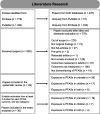Prenatal and childhood exposure to per-/polyfluoroalkyl substances (PFASs) and its associations with childhood overweight and/or obesity: a systematic review with meta-analyses
- PMID: 37580798
- PMCID: PMC10424367
- DOI: 10.1186/s12940-023-01006-6
Prenatal and childhood exposure to per-/polyfluoroalkyl substances (PFASs) and its associations with childhood overweight and/or obesity: a systematic review with meta-analyses
Abstract
Background: Per-/polyfluoroalkyl substances (PFASs) are persistent organic pollutants and suspected endocrine disruptors.
Objective: The aim of this work was to conduct a systematic review with meta-analysis to summarise the associations between prenatal or childhood exposure to PFASs and childhood overweight/obesity.
Methods: The search was performed on the bibliographic databases PubMed and Embase with text strings containing terms related to prenatal, breastfeeding, childhood, overweight, obesity, and PFASs. Only papers describing a biomonitoring study in pregnant women or in children up to 18 years that assessed body mass index (BMI), waist circumference (WC), or fat mass in children were included. When the estimates of the association between a PFAS and an outcome were reported from at least 3 studies, a meta-analysis was conducted; moreover, to correctly compare the studies, we developed a method to convert the different effect estimates and made them comparable each other. Meta-analyses were performed also stratifying by sex and age, and sensitivity analyses were also performed.
Results: In total, 484 and 779 articles were retrieved from PubMed and Embase, respectively, resulting in a total of 826 articles after merging duplicates. The papers included in this systematic review were 49: 26 evaluating prenatal exposure to PFASs, 17 childhood exposure, and 6 both. Considering a qualitative evaluation, results were conflicting, with positive, negative, and null associations. 30 papers were included in meta-analyses (19 prenatal, 7 children, and 4 both). Positive associations were evidenced between prenatal PFNA and BMI, between PFOA and BMI in children who were more than 3 years, and between prenatal PFNA and WC. Negative associations were found between prenatal PFOS and BMI in children who were 3 or less years, and between PFHxS and risk of overweight. Relatively more consistent negative associations were evidenced between childhood exposure to three PFASs (PFOA, PFOS, and PFNA) and BMI, in particular PFOS in boys. However, heterogeneity among studies was high.
Conclusion: Even though heterogeneous across studies, the pooled evidence suggests possible associations, mostly positive, between prenatal exposure to some PFASs and childhood BMI/WC; and relatively stronger evidence for negative associations between childhood exposure to PFASs and childhood BMI.
Keywords: Childhood adiposity; Early life exposure; Effect estimate conversion; Fetal exposure; Paediatric exposure; Perfluoroalkyl substances.
© 2023. BioMed Central Ltd., part of Springer Nature.
Conflict of interest statement
The authors declare no competing interests.
Figures




References
-
- WHO. Obesity and overweight. 2021. https://www.who.int/news-room/fact-sheets/detail/obesity-and-overweight . (Accessed 4 August 2021).
-
- Heymsfield SB, Wadden TA. Mechanisms, pathophysiology, and management of obesity. N Engl J Med. 2017;376:254–266. - PubMed

